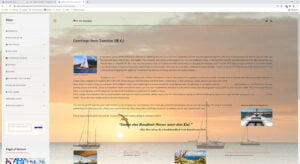Hosting Woes
Godaddy is, in my opinion as a disgruntled ex-customer, a terrible hosting provider. I’d been with them for over 10 years and at the beginning of 2022 they “upgraded” their hosting environments for several of my websites. This resulted in the original SV-ZANSHIN.COM website ceasing to function. Not a single page would render.
I’d written a lot of custom PHP code over the years and none of it worked once they’d ported the site. Plus some of the add-on packages that they once supplied are no longer present and others that I’d added are gone.
Switching Software
They did send me an e-mail before the migration stating that there might be problems. With URIs to check the “new” sites to compare them with the old. I did this, some of them worked identically and others wouldn’t even connect, so I couldn’t check the effect of the upgrade beforehand. And support was less than helpful.
GoDaddy did promise to refund me the remaining hosting time (but not the SSL certificates and registration fees, which were more expensive than the hosting). I called in February asking where my refund was, and after waiting over an hour in online chat I got someone who informed me that the amount had been credited to my account for future purchases. When I told her that I intended no future services with GoDaddy she said she could refund it to my credit card on record, and several days later the refund did actually arrive.
Transferring to Bluehost
I then transferred all of my domains and sites to Bluehost, having decided to jump into modern web interfaces and recode using WordPress. After the domains were finally transferred I tried closing my GoDaddy account. No luck, the software kept on telling me that I couldn’t close until I’d removed all my subscriptions. But I’d already done so (and removed my credit card information as well). So I waited another hour with their online support chat system – somehow in the many years I’d spent with them, I’d never once not gotten a “Thank you for messaging GoDaddy. We are experiencing higher than normal volume. Hang in there, your estimated wait time is xx minutes” regardless of when I called. And I also never waited the xx minutes, usually at least double that. After finally getting a human I explained the problem, only to get a link to the page I’d been using (despite having explained that I’d been to that page already). So here I am, still with an account because the support person couldn’t resolve the issue. I’ll have to write a real physical letter and send it.

I don’t know if I’ll ever manage to get the old site up and running, but at least there’s the internet WaybackMachine which has an older version of my website backed up!
New Site
If you’ve landed on this page you’ve most likely been redirected from the old www.sv-zanshin.com domain. Please enjoy this site!



2 thoughts on “GoDaddy ruins my original Website”
I feel your pain!
I’ve been a GODaddy customer for 20 years. Agree their customer service has gone hill since Bob Parsons sold it.
They switched five emails in my group account to MSOutlook 365 a couple of months ago. Didn’t give me any options. Will cost me hundreds if dollars a year vs less than $50 back 20 years ago. Golly, it is just email.
The e-mail issue was a big one for me as well, with the old system you could make a catch-all address for each domain and could turn off the spam filter; with their Outlook 365 account solution neither was possible. Over the years I’d used my e-mail prefix in combination with the company name so that I could see where any hacks were coming from – e.g. “arnd_linkedin@zanshin-sailing.com” or “arnd_google@zanshin-sailing.com”. Then I used the catch-all address to get mails at those addresses without having to pre-define them. I had hundreds of those, and they stopped working as well with GoDaddy’s changes.
Comments are closed.